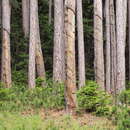Austrian pine is mainly suited to northern temperate climate zones
in the United States; it does not grow well in the southern states [
21].
Different provenances (seed sources by geographic area) or varieties are
adapted to different soil types: Austrian and Pyrenees pines grow well
on a wide range of soil types, Corsican pine grows poorly on
limestone-derived soils, and Crimean pine grows well on poorer,
limestone-derived soils. Most provenances will also show good growth on
podzolic soils. Whatever the soil type, however, the soils need to be
deep for good growth [
11,
21]. Austrian pine grows well on high pH
soils in New England. Some provenances exhibit better winter hardiness
than others [
21].
In Europe, Austrian pine is found at elevations ranging from 820
to 5,910 feet (250-1,800 m) [
21].

